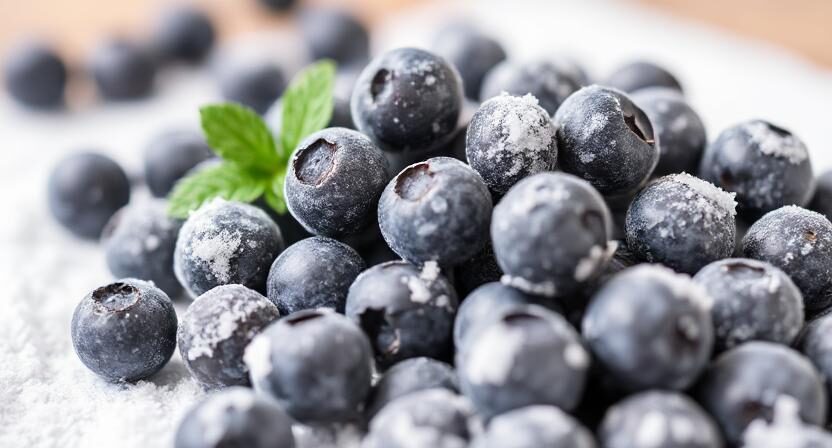
Frozen Blueberries: The Unexpected Superfood Upgrade

When it comes to fruit, fresh has always had a reputation for being best. We imagine crisp apples, ripe bananas, and of course, plump blueberries—still dewy from the farmer’s market. But what if we told you that frozen blueberries might actually be better for your health than the fresh ones? It sounds counterintuitive, but science says it’s true.
Frozen blueberries are not just a convenient snack or smoothie staple. They are antioxidant powerhouses that, in some cases, outshine their fresh counterparts. Thanks to the way freezing affects plant compounds, these icy little berries may be an underrated ally in your fight against inflammation, aging, and chronic disease.
In this post, we’re diving deep into the science behind frozen blueberries: why they may contain more disease-fighting antioxidants than fresh berries, how the freezing process affects anthocyanin levels, and what that means for your health. Whether you’re tossing them in oatmeal or blending them into a smoothie, frozen blueberries just might be one of the smartest additions to your diet.
The Power of Antioxidants in Blueberries
Blueberries are widely celebrated for their antioxidant content. These tiny berries contain a class of plant compounds known as polyphenols, with one group in particular—anthocyanins—standing out for their deep blue hue and health-protective benefits.
Antioxidants are important because they fight off free radicals, which are unstable molecules that damage cells and contribute to aging, inflammation, and disease. Chronic oxidative stress, caused by an imbalance between free radicals and antioxidants, has been linked to conditions like heart disease, diabetes, cancer, and Alzheimer’s.
What makes blueberries so powerful is their high anthocyanin concentration, which gives them their rich color and many of their healing properties. These compounds don’t just fight free radicals—they also reduce inflammation, improve blood vessel function, and may even protect brain cells from degeneration.
Why Frozen Can Be Better Than Fresh
It might surprise you to learn that freezing blueberries doesn’t destroy their nutritional value—in fact, it can enhance it. When blueberries are harvested, their nutrient content starts to degrade over time. Fresh berries often travel long distances, sit in distribution centers, and rest on grocery shelves for days before reaching your plate. During this time, exposure to oxygen, light, and heat gradually breaks down the antioxidant compounds they contain.
In contrast, frozen blueberries are picked at peak ripeness—when their antioxidant levels are highest—and then flash-frozen almost immediately. This process locks in their nutritional profile. But here’s where it gets even more interesting: studies suggest that freezing actually ruptures the structure of the berry’s cell walls, making certain antioxidants more bioavailable.
That means your body may absorb more of the anthocyanins from frozen blueberries than from fresh ones.
Freezing Enhances Anthocyanin Concentration
Anthocyanins are water-soluble pigments found in the skin and flesh of blueberries. These compounds have been studied for their powerful anti-inflammatory, anti-viral, and anti-cancer properties. They also improve cognitive function, support heart health, and help regulate blood sugar.
Freezing causes tiny ice crystals to form within the berries. These crystals puncture the cells, making it easier for your digestive system to access and absorb the nutrients inside. In one study, researchers found that freezing increased the anthocyanin concentration in blueberries compared to their fresh equivalents.
In simple terms: freezing blueberries makes their most powerful nutrients more accessible.
Frozen vs. Fresh: Nutritional Breakdown
Let’s compare frozen and fresh blueberries side by side:

While vitamin C may degrade slightly during freezing, most of the other nutrients—including fiber, vitamin K, and especially anthocyanins—are well preserved or even enhanced. So even though frozen berries may lose a small amount of water-soluble vitamins, they gain a bigger advantage where it counts most: disease-fighting plant compounds.
Anti-Inflammatory Effects of Anthocyanins
One of the biggest health benefits of anthocyanins is their anti-inflammatory power. Chronic inflammation is at the root of many modern diseases—heart disease, type 2 diabetes, obesity, autoimmune conditions, and even mental health disorders.
Anthocyanins help fight inflammation by:
- Inhibiting pro-inflammatory enzymes
- Reducing oxidative stress
- Supporting healthy endothelial function (lining of the blood vessels)
- Enhancing immune response
- Protecting brain cells from damage
Adding frozen blueberries to your diet is a simple and effective way to lower systemic inflammation and improve overall health. They’re especially beneficial for people dealing with joint pain, chronic fatigue, or inflammatory skin conditions.
Convenience Meets Longevity
Aside from nutrition, frozen blueberries win in terms of practicality. They have a longer shelf life, are often more affordable than fresh, and can be used year-round in dozens of recipes. No more worrying about your berries going bad in three days. You can store a bag in your freezer for months without any decline in quality.
Frozen blueberries also reduce food waste and allow you to buy in bulk, which is a win for both your wallet and the environment.
Creative Ways to Enjoy Frozen Blueberries
- Add them to smoothies with spinach, banana, and plant milk
- Mix into oatmeal or chia pudding for a pop of flavor and color
- Warm them up and pour over pancakes or waffles
- Use as a topping for yogurt, granola, or ice cream
- Stir into muffin or pancake batter
- Enjoy frozen right out of the bag as a refreshing snack
Their versatility makes it easy to get a daily dose of antioxidants without much effort.
What to Look For When Buying Frozen Blueberries
Not all frozen blueberries are created equal. When shopping, check the ingredients list—it should say “blueberries” and nothing else. Avoid any with added sugars, syrups, or preservatives. Organic frozen blueberries are also a good choice if you want to minimize pesticide exposure.
Pro tip: If you thaw them and notice a dark purple juice, that’s anthocyanins being released. Don’t let it go to waste—use it as part of your recipe or stir it into yogurt for an antioxidant boost.
Frozen Berries vs. Other Frozen Fruit
While most fruits lose a little bit of vitamin C and texture when frozen, berries are the exception. Because their antioxidant content is stored primarily in the skin and flesh, the freezing process tends to preserve or even enhance their health benefits.
Fruits like pineapple, mango, and bananas are still nutritious when frozen but don’t have the same level of disease-fighting polyphenols as blueberries. If you’re building an anti-inflammatory or longevity-focused diet, frozen blueberries deserve a spot at the top.
Who Should Eat More Frozen Blueberries?
- People managing chronic inflammation or autoimmune issues
- Those with cardiovascular concerns
- Athletes and fitness enthusiasts looking to speed up recovery
- Older adults looking to support brain and memory function
- Anyone who wants to boost their immune system and skin health
- Busy individuals looking for healthy convenience food options
Because blueberries are low in sugar and calories, they’re also a perfect choice for people watching their weight or managing blood sugar levels.
Myths About Frozen Produce
A common myth is that frozen fruit is nutritionally inferior to fresh. In reality, frozen produce is often just as good—if not better—because it’s harvested at peak ripeness and preserved quickly. The key is how the fruit is frozen and stored. Flash freezing helps retain nutrients, while slow freezing can cause more nutrient loss.
Frozen food isn’t “processed” in the way we think of chips or packaged snacks. If nothing is added, and the fruit is simply frozen, it remains a whole food packed with fiber, vitamins, and antioxidants.
Final Thoughts
Frozen blueberries are a prime example of how convenience and health can go hand in hand. They’re easy to store, affordable, versatile, and—most importantly—nutritionally potent. Thanks to their high levels of anthocyanins and their enhanced antioxidant availability after freezing, these little frozen gems are more than just a smoothie ingredient. They’re a daily defense system against inflammation and chronic disease.
So the next time you’re reaching into the freezer for a handful of blueberries, know that you’re not just grabbing a tasty snack—you’re nourishing your cells, reducing inflammation, and making a powerful choice for your health.
Don’t underestimate the frozen section. Sometimes, the best medicine really is cold, purple, and packed with polyphenols.
Recommended Recipes
Frozen Blueberries: The Unexpected Superfood Upgrade


Kirsten Hamilton
When it comes to fruit, fresh has always had a reputation for being best. We imagine crisp apples, ripe bananas, and of course, plump blueberries—still dewy from the farmer’s market. But what if we told you that frozen blueberries might actually be better for your health than the fresh ones? It sounds counterintuitive, but science says it’s true.
Frozen blueberries are not just a convenient snack or smoothie staple. They are antioxidant powerhouses that, in some cases, outshine their fresh counterparts. Thanks to the way freezing affects plant compounds, these icy little berries may be an underrated ally in your fight against inflammation, aging, and chronic disease.
In this post, we’re diving deep into the science behind frozen blueberries: why they may contain more disease-fighting antioxidants than fresh berries, how the freezing process affects anthocyanin levels, and what that means for your health. Whether you’re tossing them in oatmeal or blending them into a smoothie, frozen blueberries just might be one of the smartest additions to your diet.
The Power of Antioxidants in Blueberries
Blueberries are widely celebrated for their antioxidant content. These tiny berries contain a class of plant compounds known as polyphenols, with one group in particular—anthocyanins—standing out for their deep blue hue and health-protective benefits.
Antioxidants are important because they fight off free radicals, which are unstable molecules that damage cells and contribute to aging, inflammation, and disease. Chronic oxidative stress, caused by an imbalance between free radicals and antioxidants, has been linked to conditions like heart disease, diabetes, cancer, and Alzheimer’s.
What makes blueberries so powerful is their high anthocyanin concentration, which gives them their rich color and many of their healing properties. These compounds don’t just fight free radicals—they also reduce inflammation, improve blood vessel function, and may even protect brain cells from degeneration.
Why Frozen Can Be Better Than Fresh
It might surprise you to learn that freezing blueberries doesn’t destroy their nutritional value—in fact, it can enhance it. When blueberries are harvested, their nutrient content starts to degrade over time. Fresh berries often travel long distances, sit in distribution centers, and rest on grocery shelves for days before reaching your plate. During this time, exposure to oxygen, light, and heat gradually breaks down the antioxidant compounds they contain.
In contrast, frozen blueberries are picked at peak ripeness—when their antioxidant levels are highest—and then flash-frozen almost immediately. This process locks in their nutritional profile. But here’s where it gets even more interesting: studies suggest that freezing actually ruptures the structure of the berry’s cell walls, making certain antioxidants more bioavailable.
That means your body may absorb more of the anthocyanins from frozen blueberries than from fresh ones.
Freezing Enhances Anthocyanin Concentration
Anthocyanins are water-soluble pigments found in the skin and flesh of blueberries. These compounds have been studied for their powerful anti-inflammatory, anti-viral, and anti-cancer properties. They also improve cognitive function, support heart health, and help regulate blood sugar.
Freezing causes tiny ice crystals to form within the berries. These crystals puncture the cells, making it easier for your digestive system to access and absorb the nutrients inside. In one study, researchers found that freezing increased the anthocyanin concentration in blueberries compared to their fresh equivalents.
In simple terms: freezing blueberries makes their most powerful nutrients more accessible.
Frozen vs. Fresh: Nutritional Breakdown
Let’s compare frozen and fresh blueberries side by side:

While vitamin C may degrade slightly during freezing, most of the other nutrients—including fiber, vitamin K, and especially anthocyanins—are well preserved or even enhanced. So even though frozen berries may lose a small amount of water-soluble vitamins, they gain a bigger advantage where it counts most: disease-fighting plant compounds.
Anti-Inflammatory Effects of Anthocyanins
One of the biggest health benefits of anthocyanins is their anti-inflammatory power. Chronic inflammation is at the root of many modern diseases—heart disease, type 2 diabetes, obesity, autoimmune conditions, and even mental health disorders.
Anthocyanins help fight inflammation by:
- Inhibiting pro-inflammatory enzymes
- Reducing oxidative stress
- Supporting healthy endothelial function (lining of the blood vessels)
- Enhancing immune response
- Protecting brain cells from damage
Adding frozen blueberries to your diet is a simple and effective way to lower systemic inflammation and improve overall health. They’re especially beneficial for people dealing with joint pain, chronic fatigue, or inflammatory skin conditions.
Convenience Meets Longevity
Aside from nutrition, frozen blueberries win in terms of practicality. They have a longer shelf life, are often more affordable than fresh, and can be used year-round in dozens of recipes. No more worrying about your berries going bad in three days. You can store a bag in your freezer for months without any decline in quality.
Frozen blueberries also reduce food waste and allow you to buy in bulk, which is a win for both your wallet and the environment.
Creative Ways to Enjoy Frozen Blueberries
- Add them to smoothies with spinach, banana, and plant milk
- Mix into oatmeal or chia pudding for a pop of flavor and color
- Warm them up and pour over pancakes or waffles
- Use as a topping for yogurt, granola, or ice cream
- Stir into muffin or pancake batter
- Enjoy frozen right out of the bag as a refreshing snack
Their versatility makes it easy to get a daily dose of antioxidants without much effort.
What to Look For When Buying Frozen Blueberries
Not all frozen blueberries are created equal. When shopping, check the ingredients list—it should say “blueberries” and nothing else. Avoid any with added sugars, syrups, or preservatives. Organic frozen blueberries are also a good choice if you want to minimize pesticide exposure.
Pro tip: If you thaw them and notice a dark purple juice, that’s anthocyanins being released. Don’t let it go to waste—use it as part of your recipe or stir it into yogurt for an antioxidant boost.
Frozen Berries vs. Other Frozen Fruit
While most fruits lose a little bit of vitamin C and texture when frozen, berries are the exception. Because their antioxidant content is stored primarily in the skin and flesh, the freezing process tends to preserve or even enhance their health benefits.
Fruits like pineapple, mango, and bananas are still nutritious when frozen but don’t have the same level of disease-fighting polyphenols as blueberries. If you’re building an anti-inflammatory or longevity-focused diet, frozen blueberries deserve a spot at the top.
Who Should Eat More Frozen Blueberries?
- People managing chronic inflammation or autoimmune issues
- Those with cardiovascular concerns
- Athletes and fitness enthusiasts looking to speed up recovery
- Older adults looking to support brain and memory function
- Anyone who wants to boost their immune system and skin health
- Busy individuals looking for healthy convenience food options
Because blueberries are low in sugar and calories, they’re also a perfect choice for people watching their weight or managing blood sugar levels.
Myths About Frozen Produce
A common myth is that frozen fruit is nutritionally inferior to fresh. In reality, frozen produce is often just as good—if not better—because it’s harvested at peak ripeness and preserved quickly. The key is how the fruit is frozen and stored. Flash freezing helps retain nutrients, while slow freezing can cause more nutrient loss.
Frozen food isn’t “processed” in the way we think of chips or packaged snacks. If nothing is added, and the fruit is simply frozen, it remains a whole food packed with fiber, vitamins, and antioxidants.
Final Thoughts
Frozen blueberries are a prime example of how convenience and health can go hand in hand. They’re easy to store, affordable, versatile, and—most importantly—nutritionally potent. Thanks to their high levels of anthocyanins and their enhanced antioxidant availability after freezing, these little frozen gems are more than just a smoothie ingredient. They’re a daily defense system against inflammation and chronic disease.
So the next time you’re reaching into the freezer for a handful of blueberries, know that you’re not just grabbing a tasty snack—you’re nourishing your cells, reducing inflammation, and making a powerful choice for your health.
Don’t underestimate the frozen section. Sometimes, the best medicine really is cold, purple, and packed with polyphenols.

The Wellness Menu values your privacy and keeps your personal information secure. We use your data only to provide and improve our services and never share it with third parties unless required by law. By using our website, you agree to this policy.







GIPHY App Key not set. Please check settings